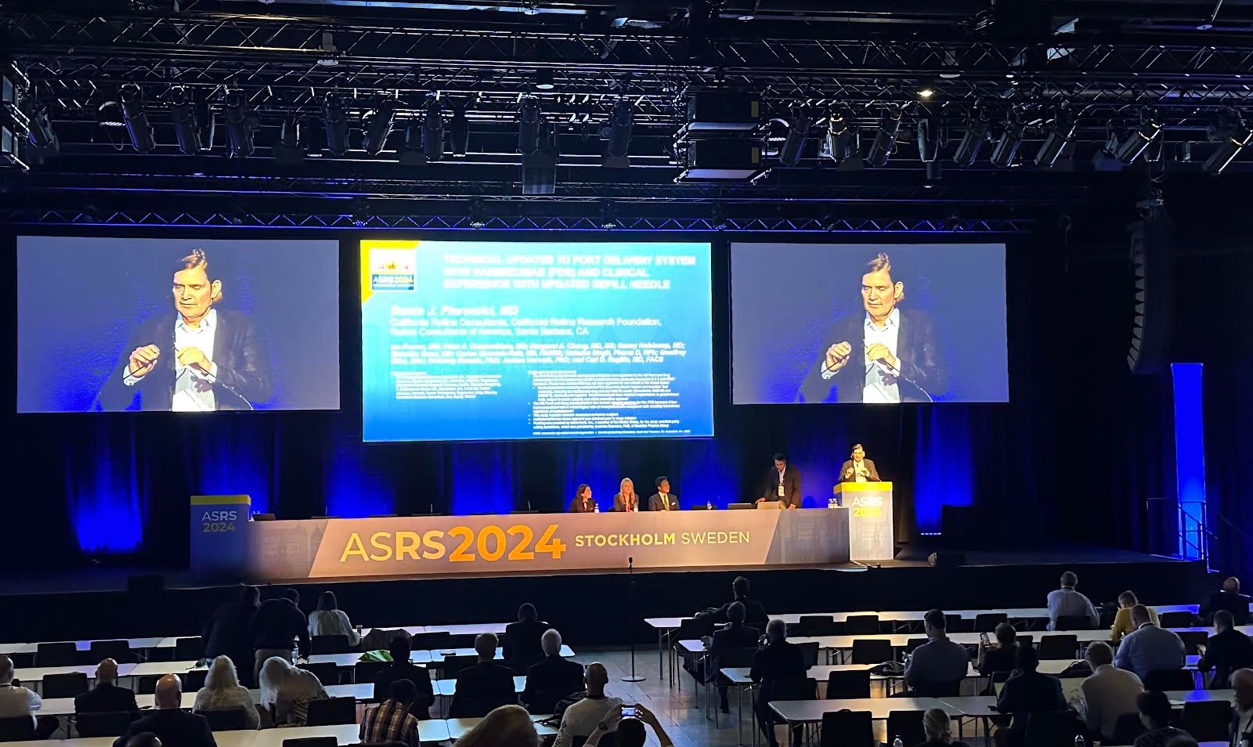Lindsay Kozek MD, PhD
Massachusetts Eye and Ear Infirmary, Boston, MA
This session, moderated by Robert A. Mittra, MD, provided both technical updates regarding the Port Delivery System as well as readouts of several ongoing studies using the device.
Technical Updates to Port Delivery System With Ranibizumab and Clinical Experience With Updated Refill Needle
Dante J. Pieramici, MD
Dr. Pieramici reviewed the voluntary recall of the port delivery system (PDS) that was in effect from 2021-2022. A root cause analysis was performed, and a mechanical malfunction was identified that resulted in septum dislodgement into the body of the device, making it unrefillable in some cases. A new updated implant was designed with improved bond strength of the septum. The needle has also been updated to reduce insertion force. With this updated device, testing with over thirty years of simulated use showed no dislodgements (versus a 50% rate with the previous model). The PDS is thus now re-FDA approved and the voluntary recall has been terminated.

Port Delivery System With Ranibizumab for Continuous Treatment in Diabetic Retinopathy: First Readout of 2-Year Data From the Phase 3 Pavilion Trial
Margaret A Chang, MD, MS
Dr. Chang presented the two-year data from Phase 3 Pavilion trial regarding use of the PDS with ranibizumab for continuous treatment in diabetic retinopathy. The primary endpoint showed superior efficacy of the PDS compared with controls (undergoing clinical monitoring) with treated patients achieving a two-step improvement in ETDRS from baseline at week 52. There was one refill exchange every 9 months, and PDS patients had low rates of both endophthalmitis and conjunctival complications. Twenty percent of controls developed proliferative diabetic retinopathy (PDR) or neovascularization (NV) over 1 year versus none of patients treated with PDS. Moreover, patients treated with PDS were able to maintain treatment through week 100. Control patients demonstrated improvement after crossover to PDS.
Port Delivery System With Ranibizumab for Continuous Treatment of Diabetic Macular Edema: First Readout of the Phase 3 Pagoda Trial Year 2 Results
Carl C Awh, MD, FASRS
Dr. Awh presented the first readout of the 2 year results from the ongoing multi-center Phase 3 Pagoda randomized trial using the port delivery system with ranibizumab for continuous treatment of diabetic macular edema (DME). The PDS, refilled every 24 weeks, was compared to monthly intravitreal injections with 0.5 mg ranibizumab. All patients received 4 monthly loading doses, followed by randomization. The trial met its primary endpoint, showing that the PDS was non-inferior to intravitreal ranibizumab injections in terms of BCVA change from baseline at 1 year. After the primary endpoint, patients randomized to intravitreal ranibizumab were allowed to cross over to the PDS arm. Patients who crossed over to the PDS arm had noninferior outcomes at 2 years. Visual and anatomical outcomes were maintained at 2 years. In terms of endophthalmitis, there were no cases in the first year and 4 cases in the second year, all of whom returned to their baseline vision. Overall, the PDS showed robust efficacy for treatment of DME with no new safety concerns.
Clinical Benefits of Continuous Delivery of Anti-VEGF Ranibizumab With the Port Delivery System in Neovascular Age-Related Macular Degeneration
Aleksandra V Rachitskaya, MD, FASRS
Dr. Rachitskaya presented data regarding use of the PDS for neovascular age-related macular degeneration (nAMD). Patients with continuous delivery of ranibizumab via the PDS, refilled every 24 weeks, showed long term visual acuity and anatomical gains that were maintained over 144 weeks. 95% of patients in the PDS arm did not require supplemental treatment with intravitreal injection, and subjectively, 90% of patients who switched from intravitreal injections to the PDS preferred the PDS.
The panel then took questions from the audience, with the assistance of moderator Dr. Mittra, who posed the starter question, “What is keeping retina specialists from adapting the Port Delivery System?” In the Preferences & Trends survey, after the PDS was recalled, 40% of those surveyed said that they would not use the PDS, and the most recent survey now shows this number increased to nearly 60%. Potential hurdles included the fact that unlike intravitreal injections, the PDS requires a surgical procedure for implementation, so the implanting ophthalmologist must be trained in vitreoretinal surgery. Others mentioned concerns about complications, specifically endophthalmitis, including late-onset endophthalmitis.
Overall, the data presented regarding the PDS demonstrate consistent long term VEGF suppression with benefits in diabetic retinopathy, diabetic macular edema, and neovascular AMD, with no new safety concerns.